The Compressive Properties and Deformation Mechanism of Closed-Cell Aluminum Foam with High Porosity after High-Temperature Treatment
Abstract
1. Introduction
2. Design of the Experiment
2.1. Sample Preparation
2.2. High-Temperature Treatment of Specimens
2.3. Quasi-Static Compression Experiment
3. Experimental Results and Analysis
3.1. Compression Deformation Process Analysis
- (1)
- When the load is small (the strain is less than 0.05), the cell structure of aluminum foam mainly deforms by elastic bending. However, the cell structure remains intact, and the structure does not fail. The cell structure’s form can recover in time after unloading, as depicted in Figure 4a,b.
- (2)
- (3)
- With the further increase in the compression load, a larger range of yield zones appear in the aluminum foam’s cell wall structure, and part of the cell structure collapses, as shown in Figure 4d,e. Thereafter, the aluminum foam’s cell collapses in a large volume, as illustrated in Figure 4f,g. The cell structure is completely destroyed and compacted, and the cell walls start to stack and squeeze each other, as presented in Figure 5b. Owing to the complete disappearance of cells, the compression process ends, and the force characteristics enter the densification stage from the plateau stage, with a subsequent rapid increase in stress.
3.2. Stress–Strain Characteristics
- (1)
- Quasi-elastic stage: at the beginning of loading, the load is small, the aluminum foam matrix and the cell structure are mainly subjected to elastic deformation, the strain is small (less than 0.05), and the stress increases linearly.
- (2)
- Plateau stage: With the increase in force deformation of the aluminum foam matrix and cell structure, the aluminum foam’s cell structure is damaged, some cells crack and start to collapse, and the compression curve enters the plateau stage. In the compression process, the aluminum foam’s cells first produce bending yielding, and the cell wall structure does not immediately but slowly deforms until the cell space is completely compressed. At this stage (strain is in the range 0.05–0.5), with the increase in strain, the stress changes minimally, which reflects that the closed-cell aluminum foam material has strong energy absorption characteristics.
- (3)
- With the continuous collapse of the aluminum foam’s cells, the cells will be completely compacted, the aluminum foam matrix starts to stack densely on top of each other, and the compression curve enters the densification stage. In this stage, the stress rises sharply, and the slope of the tangent line of the stress–strain curve increases with the increase in strain.
3.3. Compression Mechanical Property Analysis
- (1)
- Elastic gradient (Es): gradient of the elastic straight lines between stresses of 0.7- and 0.2-times plateau stress.
- (2)
- Compressive proof strength (σy): compressive stress at a plastic compressive strain of 0.01.
- (3)
- Plateau stress (σpl): arithmetical mean of the stresses at smaller strain intervals between 0.2 and 0.4 compressive strain.
- (1)
- With an increase in the heat treatment temperature, the elastic gradient, compressive proof strength, and plateau stress of the aluminum foam material generally show a small decreasing trend. When the heating temperature is less than 600 °C, the compressive mechanical properties of the aluminum foam material decrease to a lesser extent. However, when the heating temperature reaches 700 °C, the structure of the closed-cell aluminum foam changes, the aluminum foam specimen is seriously deformed, and there is no experimental condition to complete the compression experiment.
- (2)
- After the aluminum foam is heated to 200 °C, 400 °C, and 600 °C, its mechanical parameters show a similar pattern, i.e., the mechanical parameters of aluminum foam materials with lower porosity perform better. The reason is that with a decrease in porosity, the aluminum matrix content of aluminum foam materials increases, the percentage of pore volume decreases, the thickness of each cell wall increases, and the resistance of aluminum foam specimens to compressive deformation is enhanced. They show better compressive mechanical properties overall.
4. Constitutive Model of Closed-Cell Aluminum Foam Based on Experiment
5. Conclusions
- (1)
- Quasi-static compression performance tests on closed-cell aluminum foam materials after high-temperature treatment were carried out to reveal the mechanism of deformation failure of the materials. The results showed that the compressive deformation process of closed-cell aluminum foam specimens exhibited significant stage characteristics, namely, a quasi-elastic deformation stage of the aluminum foam matrix and cell structure → a plateau stage of the aluminum foam’s cell structure destabilization and damage → a densification stage of the aluminum foam’s cell collapse and stacking.
- (2)
- The variation law of the mechanical properties of closed-cell aluminum foam materials with porosity and heat treatment temperatures was obtained. That is, with a decrease in porosity, the aluminum matrix content of aluminum foam materials increased, the thickness of cell walls increased, and the resistance of aluminum foam specimens to compressive deformation was enhanced. They showed better compressive mechanical properties overall. With an increase in the heat treatment temperature, the elastic modulus, compressive proof strength, and plateau stress values of aluminum foam materials generally demonstrated a small decrease in the trend of change. When the heating temperature reached 700 °C, the closed-cell aluminum foam structure was completely destroyed.
- (3)
- A constitutive model of closed-cell aluminum foam materials considering porosity based on the experimental results was established. Likewise, in accordance with the experimental results, the correlation function between material parameters and porosity in the Liu–Subhash constitutive model was established using the method of multiparameter regression analysis. Then, a constitutive model of aluminum foam materials that can consider porosity was established. The validation results showed that the model predictions were in good agreement with the experimental results, indicating that the established modified constitutive model of closed-cell aluminum foam can efficiently characterize the stress–strain process of the material and is referable.
Author Contributions
Funding
Data Availability Statement
Acknowledgments
Conflicts of Interest
References
- Zeng, S. Analysis of the influence of the characteristics of mountain soil and the noise in the tunnel on people: Active noise control system. Arab. J. Geosci. 2021, 14, 1–16. [Google Scholar]
- Opiela, K.C.; Zielinski, T.G.; Dvorak, T.; Kudela, S., Jr. Perforated closed-cell aluminium foam for acoustic absorption. Appl. Acoust. 2021, 174, 107706. [Google Scholar] [CrossRef]
- Lu, T.; Hess, A.; Ashby, M. Sound absorption in metallic foams. J. Appl. Phys. 1999, 85, 7528–7539. [Google Scholar] [CrossRef]
- Navacerrada, M.A.; Fernandez, P.; Diaz, C.; Pedrero, A. Thermal and acoustic properties of aluminium foams manufactured by the infiltration process. Appl. Acoust. 2013, 74, 496–501. [Google Scholar] [CrossRef]
- Ye, H.; Ma, M.; Ni, Q. An experimental study on mid-high temperature effective thermal conductivity of the closed-cell aluminum foam. Appl. Therm. Eng. 2015, 77, 127–133. [Google Scholar] [CrossRef]
- Grilec, K.; Marić, G.; Miloš, K. Aluminium Foams in the Design of Transport Means. J. Traffic Transp. Eng. 2012, 24, 295–304. [Google Scholar] [CrossRef][Green Version]
- Dineshkumar, J.; Jesudas, T.; Elayaraja, R. Characteristics, applications and processing of aluminium foams—A Review. Mater. Today Proc. 2021, 42, 1773–1776. [Google Scholar] [CrossRef]
- Singh, D.; Mittal, A.; Jain, V.; Gupta, D.; Singla, V.K. Investigations on Fabrication Techniques of Aluminium-Based Porous Material. Adv. Manuf. Process. 2019, 219–227. [Google Scholar] [CrossRef]
- Voronin, S.V.; Loboda, P.S.; Gorkunov, E.S.; Panin, V.E.; Ramasubbu, S. Methods for producing foamed aluminum. AIP Conf. Proc. 2017, 1915, 40064. [Google Scholar]
- Karuppasamy, R.; Barik, D. Production methods of aluminium foam: A brief review. Mater. Today Proc. 2021, 37, 1584–1587. [Google Scholar] [CrossRef]
- Rajak, D.K.; Kumaraswamidhas, L.A.; Das, S. Technical Overview of Aluminum Alloy Foam. Rev. Adv. Mater. Sci. 2017, 49, 68–86. [Google Scholar]
- Haag, F.; Galio, A.; Schaeffer, L. Uniaxial compression tests of aluminium foams. Proc. Inst. Mech Eng. Part B-J. Eng. Manuf. 2002, 216, 633–636. [Google Scholar] [CrossRef]
- Yamada, Y.; Banno, T.; Xie, Z.K.; Wen, C.E. Compressive Deformation Behaviour of a Closed-Cell Aluminum. Mater. Sci. Forum. 2006, 510–511, 150–153. [Google Scholar]
- Ruan, D.; Lu, G.; Chen, F.; Siores, E. Compressive behaviour of aluminium foams at low and medium strain rates. Compos. Struct. 2002, 57, 331–336. [Google Scholar] [CrossRef]
- Forest, S.; Blazy, J.S.; Chastel, Y.; Moussy, F. Continuum modeling of strain localization phenomena in metallic foams. J. Mater. Sci. 2005, 40, 5903–5910. [Google Scholar] [CrossRef]
- Ding, Y.; Wang, S.; Zheng, Z.; Yang, L.; Yu, J. Dynamic crushing of cellular materials: A unique dynamic stress—Strain state curve. Mech. Mater. 2016, 100, 219–231. [Google Scholar] [CrossRef]
- Zheng, Z.; Yu, J.; Wang, C.; Liao, S.; Liu, Y. Dynamic crushing of cellular materials: A unified framework of plastic shock wave models. Int. J. Impact Eng. 2013, 53, 29–43. [Google Scholar] [CrossRef]
- Cowie, T.; Gurnham, C.W.A.; Braithwaite, C.H.; Lea, L.; Chau, R.; Germann, T.C.; Lane, J.M.D.; Brown, E.N.; Eggert, J.H.; Knudson, M.D. Impact performance of aluminium foams in a direct impact Hopkinson bar. AIP Conf. Proc. 2018, 1979, 110003. [Google Scholar]
- Irausquin, I.; Perez-Castellanos, J.L.; Miranda, V.; Teixeira-Dias, F. Evaluation of the effect of the strain rate on the compressive response of a closed-cell aluminium foam using the split Hopkinson pressure bar test. Mater. Des. 2013, 47, 698–705. [Google Scholar] [CrossRef][Green Version]
- Liu, Q.; Subhash, G. A phenomenological constitutive model for foams under large deformations. Polym. Eng. Sci. 2004, 44, 463–473. [Google Scholar] [CrossRef]
- Xi, H.; Liu, Y.; Tang, L.; Liu, Z.; Mu, J.; Yang, B. Constitutive model of aluminum foam with temperature effect under quasi-static compression. J. Harbin Eng. Univ. 2013, 34, 6. [Google Scholar]
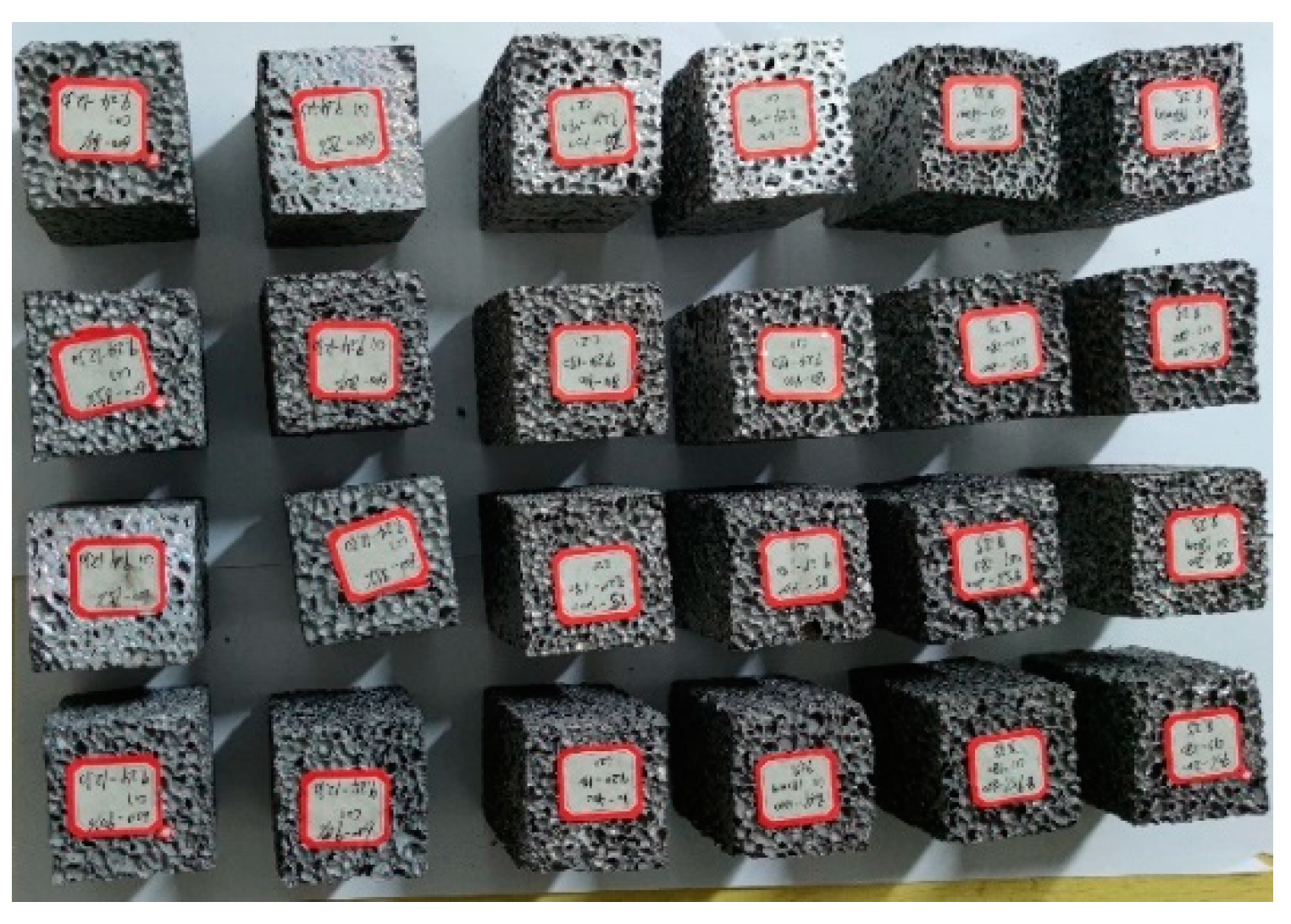
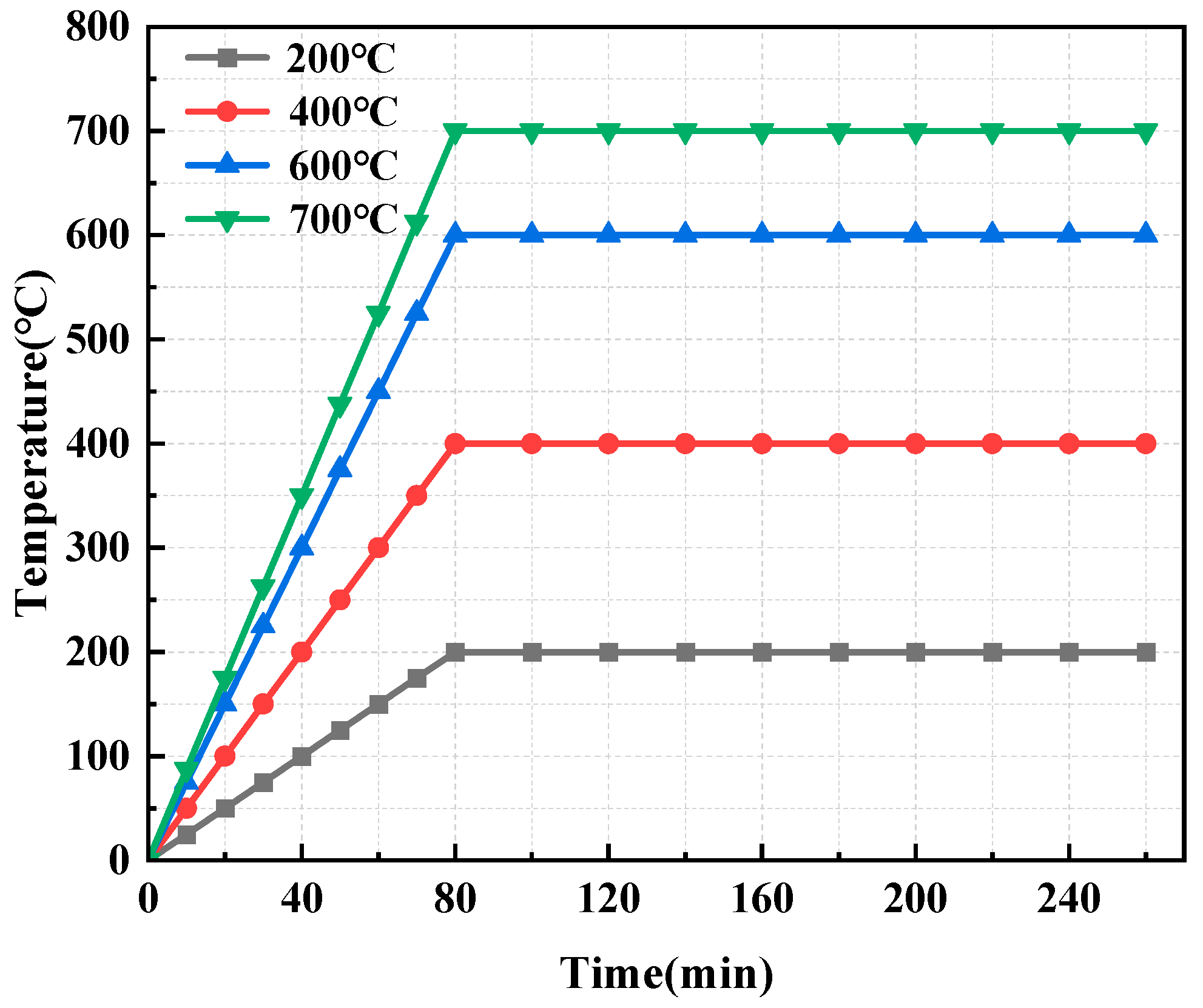
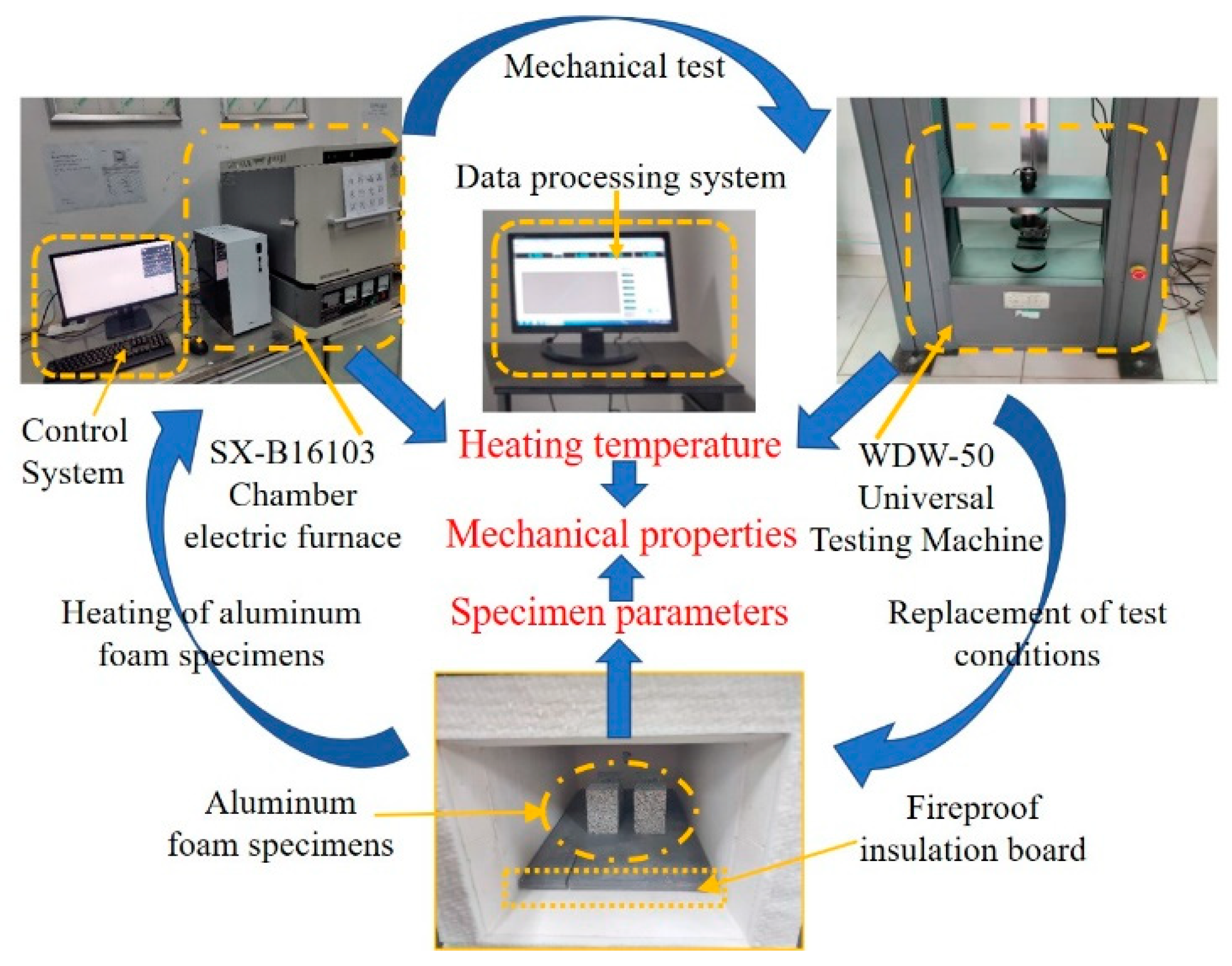



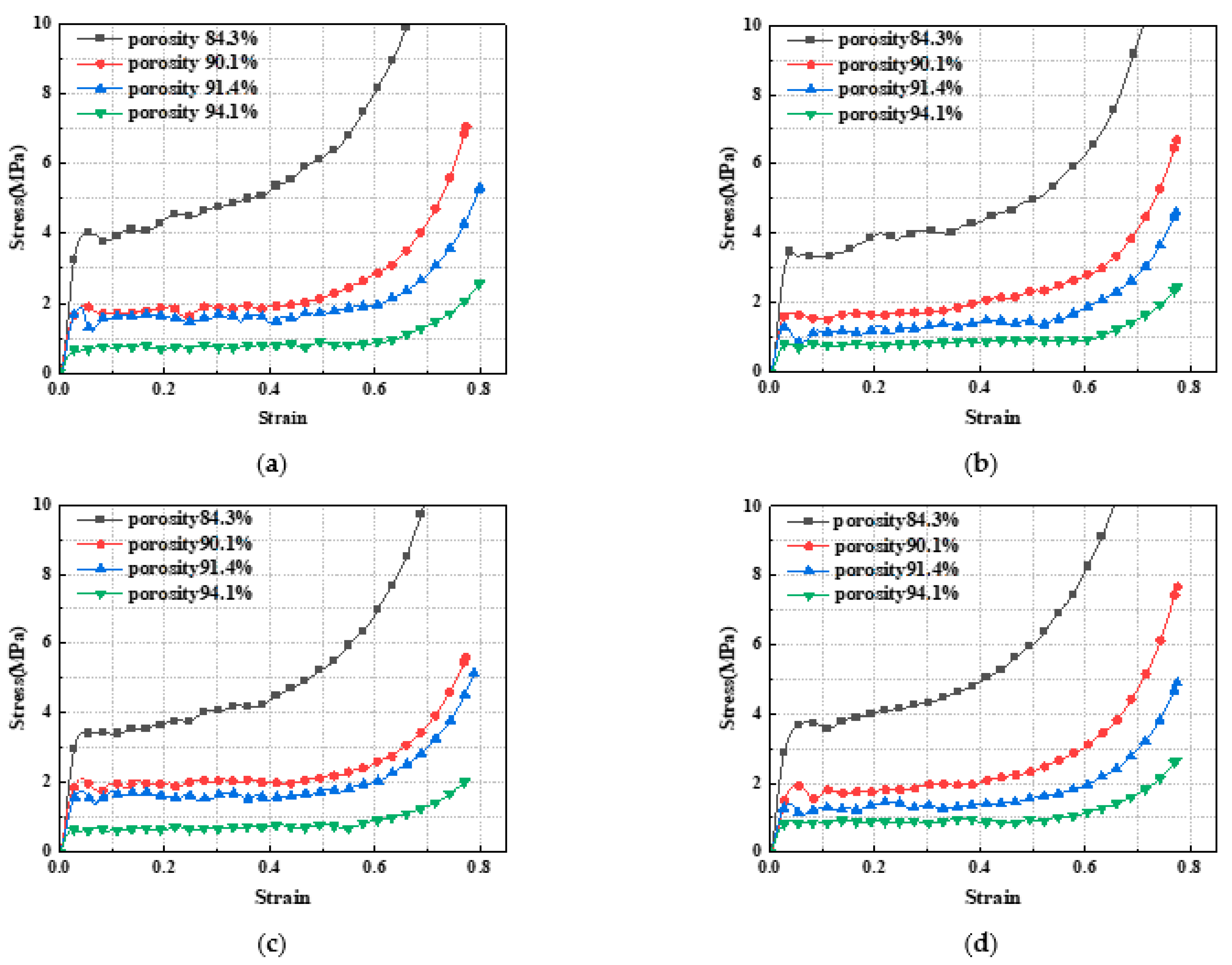



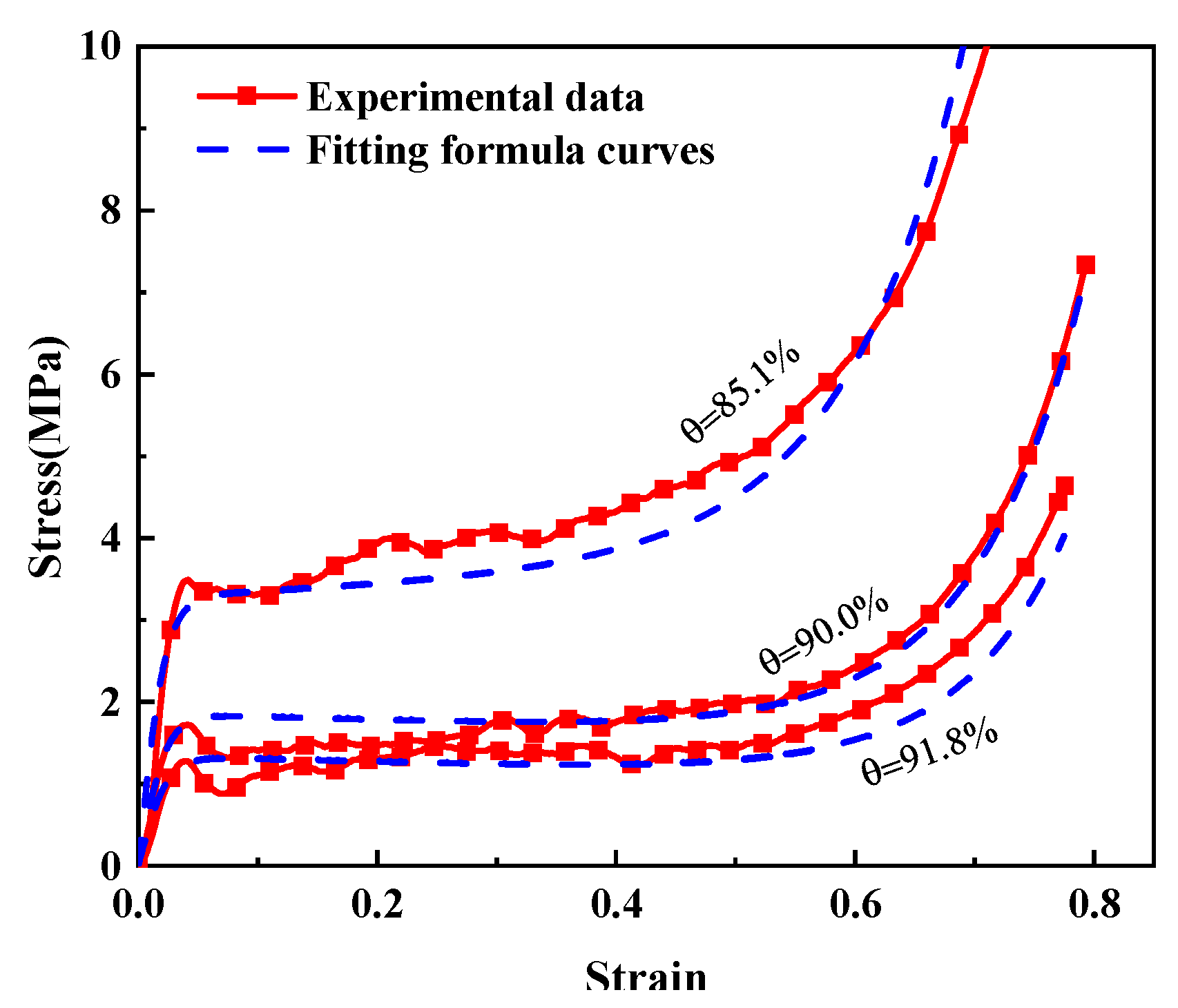
| T/°C | Porosity | ||||||||
|---|---|---|---|---|---|---|---|---|---|
| MPa | 84.3% | 90.1% | 91.4% | 94.1% | |||||
| Average Value | Standard Deviation | Average Value | Standard Deviation | Average Value | Standard Deviation | Average Value | Standard Deviation | ||
| 25 | Es1 | 134.03 | 6.919 | 88.58 | 0.009 | 75.67 | 2.976 | 23.15 | 3.561 |
| σy2 | 3.69 | 0.102 | 1.86 | 0.120 | 1.55 | 0.105 | 0.54 | 0.067 | |
| σpl3 | 4.67 | 0.077 | 1.94 | 0.007 | 1.46 | 0.066 | 0.67 | 0.073 | |
| 200 | Es1 | 117.17 | 6.116 | 75.09 | 3.326 | 71.20 | 3.066 | 36.65 | 2.121 |
| σy2 | 3.18 | 0.132 | 1.66 | 0.030 | 1.48 | 0.067 | 0.67 | 0.057 | |
| σpl3 | 4.03 | 0.011 | 1.81 | 0.034 | 1.48 | 0.059 | 0.73 | 0.062 | |
| 400 | Es1 | 122.12 | 6.133 | 81.36 | 4.646 | 61.62 | 2.957 | 28.13 | 1.895 |
| σy2 | 3.18 | 0.149 | 1.88 | 0.092 | 1.47 | 0.078 | 0.57 | 0.047 | |
| σpl3 | 3.90 | 0.105 | 2.02 | 0.002 | 1.50 | 0.079 | 0.68 | 0.010 | |
| 600 | Es1 | 115.95 | 5.394 | 71.50 | 0.207 | 72.41 | 4.371 | 36.45 | 2.294 |
| σy2 | 3.83 | 0.172 | 1.73 | 0.003 | 1.47 | 0.083 | 0.76 | 0.058 | |
| σpl3 | 4.85 | 0.282 | 1.98 | 0.069 | 1.49 | 0.102 | 0.78 | 0.069 | |
| Porosity/% | C1 | C2 | C3 | C4 | C5 |
|---|---|---|---|---|---|
| 84.3% | 3.48 | 90.48 | 89.60 | −5.31 | 10.28 |
| 90.1% | 1.86 | 84.86 | 84.87 | −6.41 | 10.21 |
| 91.4% | 1.46 | 83.45 | 83.45 | −7.28 | 10.91 |
| 94.1% | 0.66 | 79.68 | 79.59 | −9.01 | 11.81 |
Publisher’s Note: MDPI stays neutral with regard to jurisdictional claims in published maps and institutional affiliations. |
© 2022 by the authors. Licensee MDPI, Basel, Switzerland. This article is an open access article distributed under the terms and conditions of the Creative Commons Attribution (CC BY) license (https://creativecommons.org/licenses/by/4.0/).
Share and Cite
Zhang, H.; Lei, M.; Lin, Z.; Gong, W.; Shen, J.; Zhang, Y. The Compressive Properties and Deformation Mechanism of Closed-Cell Aluminum Foam with High Porosity after High-Temperature Treatment. Sustainability 2022, 14, 9850. https://doi.org/10.3390/su14169850
Zhang H, Lei M, Lin Z, Gong W, Shen J, Zhang Y. The Compressive Properties and Deformation Mechanism of Closed-Cell Aluminum Foam with High Porosity after High-Temperature Treatment. Sustainability. 2022; 14(16):9850. https://doi.org/10.3390/su14169850
Chicago/Turabian StyleZhang, Hu, Mingfeng Lei, Zanquan Lin, Weipeng Gong, Jiajia Shen, and Yunbo Zhang. 2022. "The Compressive Properties and Deformation Mechanism of Closed-Cell Aluminum Foam with High Porosity after High-Temperature Treatment" Sustainability 14, no. 16: 9850. https://doi.org/10.3390/su14169850
APA StyleZhang, H., Lei, M., Lin, Z., Gong, W., Shen, J., & Zhang, Y. (2022). The Compressive Properties and Deformation Mechanism of Closed-Cell Aluminum Foam with High Porosity after High-Temperature Treatment. Sustainability, 14(16), 9850. https://doi.org/10.3390/su14169850







